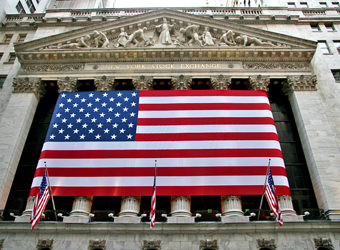U.S. stocks closed mostly higher Wednesday, with energy leading, as investors digested economic data and the start of the United Kingdom’s divorce from the European Union.
The Dow Jones industrial average fell about 40 points, with United Health contributing the most losses.
“We might be seeing a bit of buyer’s remorse from yesterday,” said Mike Bailey, director of research at FBB Capital Partners. He also said that “there is a realisation that Brexit is actually happening.”
The S&P 500 ended 0.1 percent higher, with energy rising 1.2 percent. The sector popped after weekly data from the Energy Information Administration showed a smaller-than-expected crude inventory build. U.S. crude rose 2.4 percent to settle at $49.51 per barrel.
The Nasdaq outperformed, rising 0.4 percent higher.
“The market is trading in a wait-and-see mode to see whether the administration will be able to move on with tax reform,” said Ernie Cecilia, CIO at Bryn Mawr Trust.
U.S. equities rallied on Tuesday, on the back of strong consumer confidence data while worries about the Trump administration’s ability to push through key reforms dissipated.
“What’s frustrating is I don’t know if yesterday is an indication that things are back on track,” said Tom Siomades, head of Hartford Funds Investment Consulting Group. “There seems to be a lack of progress” on the Trump agenda.
President Donald Trump’s administration took a blow on Friday after a bill intended to replace Obamacare was defeated, leaving investors wondering if tax reform, deregulation and government spending will pass through Congress.
Tom Martin, senior portfolio manager at Globalt, said the defeat could “help Republicans to find more common ground” on the administration’s pro-growth proposals.
Stocks are on track to record a mixed month, with the Nasdaq poised for a gain of around 1 percent, while the S&P and Dow tracked for monthly losses of around 0.1 percent and 0.7 percent, respectively.
Overseas, Britain’s ambassador to the EU, Tim Barrow, handed the official letter triggering Article 50 to European Council President Donald Tusk. This commences the country’s two-year exit process from the trading bloc.
“I don’t think the market sees Brexit as a positive or a negative right now because there is no historical precedent,” said Randy Frederick, vice president of trading and derivatives at Charles Schwab. “I think the market had been expecting the triggering of Article 50 since way back last year, so I don’t think there was any surprise.”
The British pound gyrated against the dollar. Sterling held around $1.244, down 0.06 percent.
“None of this is a surprise. Today is day one of a divorce, meaning we’re entering phase one of negotiations,” said Minh Trang, senior FX trader at Silicon Valley Bank.
But Dan Ryan, financial services advisory practice leader at PwC, said that some companies — especially banks — are not going to wait two years for the process to end.
“CEOs like certainty and the process is anything but,” he said. “I think now you’re going to see more companies announce moves out of the UK. They hadn’t done so before because there was a bit of hope that they wouldn’t leave the EU.”
Investors in Europe also contended with news out of the European Central Bank. Reuters reported, citing sources, that the central bank was wary of pushing a fresh policy message amid concerns of a yield surge.
Yields in the region and in the U.S. fell. The U.S. 10-year note yield slipped to around 2.383 percent, while the 10-year German bund yielded 0.34 percent.
“What the ECB wants to do is prepare the market for the fact that tapering may not happen that soon as it is expecting,” said Naeem Aslam, chief market strategist at Think Markets. “They are right to do so because we do not know what the aftermath of Brexit will be.”
European equities ended higher, with the pan-European Stoxx 600 index rising 0.33 percent.
In economic news, weekly mortgage applications held flat. Pending home sales data showed a 5.5 percent increase in February.
The Dow Jones industrial average fell 42.18 points, or 0.2 percent, to close at 20,659.32, with UnitedHealth leading decliners and Chevron the top advancer.
The S&P 500 rose 2.56 points, or 0.11percent, to end at 2,361.13, with energy leading five sectors higher and financials lagging.
The Nasdaq composite rose 22.41 points, or 0.38 percent, to close at 5,897.55.
About nine stocks advanced for every five decliners at the New York Stock Exchange, with an exchange volume of 727.61 million and a composite volume of 3.085 billion at the close.
The CBOE Volatility Index (VIX), widely considered the best gauge of fear in the market, traded near 11.4.
Thursday
8:30 a.m. Jobless
8:30 a.m. Q4 Real GDP
9:45 a.m. Cleveland Fed President Loretta Mester
11:00 a.m. Dallas Fed’s Kaplan
11:15 a.m. San Francisco Fed’s Williams
4:30 p.m. New York Fed President William Dudley
Friday
8:30 a.m. Personal income
8:30 a.m. Consumer spending
8:30 a.m. Core PCE prices
9:45 a.m. Chicago PMI
10:00 a.m. Consumer sentiment
10:00 a.m. Minneapolis Fed President Neel Kashkari
10:30 a.m. St. Louis Fed President James Bullard
Source: CNBC


